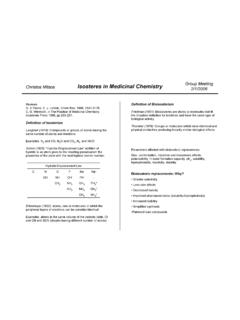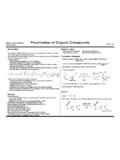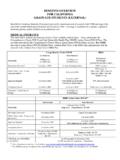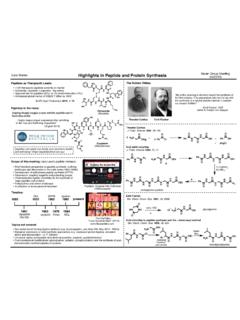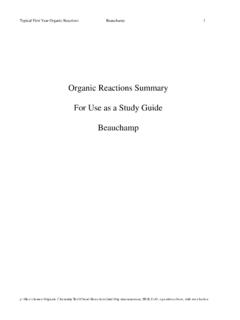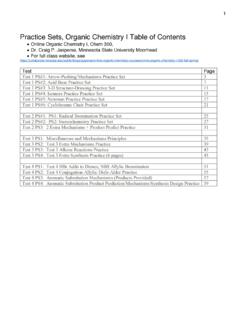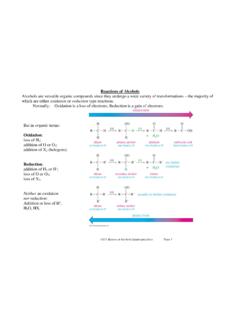Transcription of Proline-Catalyzed Direct Asymmetric Aldol Reactions
1 Proline-Catalyzed Direct Asymmetric AldolReactionsBenjamin List,* Richard A. Lerner, and Carlos F. Barbas IIIThe Skaggs Institute for Chemical Biologyand the Department of Molecular BiologyThe Scripps Research Institute10550 North Torrey Pines Road, La Jolla, California 92037 ReceiVed December 7, 1999 Most enzymatic transformations have a synthetic though, the mechanisms by which natural and syntheticcatalysts operate differ markedly. The catalytic Asymmetric aldolreaction as a fundamental C-C bond forming reaction inchemistry and biology is an interesting case in this , this reaction is dominated by approaches that utilizepreformed enolate equivalents in combination with a , a metal is involved in the reaction enzymes, however, use a fundamentally different strategyand catalyze the Direct aldolization of two unmodified carbonylcompounds. Class I aldolases utilize an enamine based mecha-nism,2while Class II aldolases mediate this process by using azinc development of aldolase antibodies that usean enamine mechanism and accept hydrophobic organic substrateshas demonstrated the potential inherent in amine-catalyzedasymmetric Aldol , the first small-moleculeasymmetric class II aldolase mimics have been described in theform of zinc, lanthanum, and barium ,6 However,amine-based Asymmetric class I aldolase mimics have not beendescribed in the we report our finding that theamino acid proline is an effective Asymmetric catalyst for thedirect Aldol reaction between unmodified acetone and a varietyof we developed broad scope aldolase antibodies thatshow very high enantioselectivities, have enzymatic rate accelera-tions, and use the enamine mechanism of class I course of these studies.
2 We found that one of our aldolasecatalytic antibodies (Aldolase Antibody 38C2, Aldrich) is anefficient catalyst for enantiogroup-differentiating Aldol cyclode-hydrations of 2,6-heptanediones to give cyclohexenones, includingthe Wieland-Miescher ,9 These intramolecular reactionsare also catalyzed by proline (Hajos-Eder-Sauer-Wiechertreaction)10and it has been postulated that they proceed via anenamine , the Proline-Catalyzed directintermolecular Asymmetric Aldol reaction has not been , there are no Asymmetric small-molecule Aldol catalyststhat use an enamine on our own results andShibasaki s work on lanthanum-based small-molecule aldolcatalysts,4,6we realized the great potential of catalysts for thedirect Asymmetric Aldol initially studied the reaction of acetone with 4-nitroben-zaldehyde. Reacting proline (30 mol %) in DMSO/acetone (4:1)with 4-nitrobenzaldehyde at room temperature for 4 h furnishedaldol product (R)-1in 68% yield and 76% ee (eq 1).
3 This resultis quite remarkable since it is known that proline can undergo avariety of Reactions with aldehydes. For example, aliphaticaldehydes react with proline to give either the oxazolidinone and/or various other compounds, including products of aldehydes (including 4-nitrobenzaldehyde) cancondense with proline to form azomethine ylides that undergofurther 1,3-dipolar cycloaddition high concentrationof acetone we use in the reaction mixture suppresses these sidereactions. The only significant side product is theR, -unsaturatedketone, formed by Aldol (or Mannich-type) condensation. Afterscreening several solvents,14we found anhydrous DMSO at roomtemperature to be the most suitable condition regarding reactiontimes and enantioselectivity. We also compared a variety ofdifferent commercially available amino acid derivatives understandard conditions with 30-40 mol % of catalyst (Table 1).Interestingly, primary amino acids and acyclic secondary aminoacids failed to give significant amounts of the desired product(entries 1 and 2).
4 While 2-azetidinecarboxylic acid showed somecatalysis (entry 3), both pipecolic acid (entry 5) and 2-pyrrolidinecarboxamide (entry 6) were uneffective. Clearly both the pyrro-lidine ringandthe carboxylate are essential for efficient catalysisto occur. On the other hand, none of the commercially availableproline derivatives (entries 7-9) showed significantly improvedenantioselectivity compared to proline itself. Synthesis of other(1) Reviews: (a) Nelson, S. : Asymmetry1998,9, 357-389. (b) Gro ger, H.; Vogl, E. M.; Shibasaki, Eur. ,4, 1137.(c) Bach, T. Angew. Chem., Int. Ed. ,33, 417. (d) A notableexception is Denmark s chiral Lewis base- catalyzed Mukayama-type aldolreaction: Denmark, S. E.; Stavenger, R. A.; Wong, Org. ,63, 918-919.(2) (a) March, J. J.; Lebherz, H. ,17, 110. (b) Rutter, W. Proc. Am. Soc. Exp. ,23, 1248. (c) Lai, C. Y.; Nakai, N.;Chang, ,183, 1204. (d) Morris, A. J.; Tolan, D. R.
5 ;Biochemistry1994,33, 12291.(3) Fessner, ; Schneider, A.; Held, H.; Sinerius, G.; Walter, C.; Hixon,M.; Schloss, J. Chem., Int. Ed. ,35, aldolases use a preformed enolate, phosphoenolpyruvate,to accomplish Aldol addition Reactions . For studies of this and other aldolaseenzymes in organic synthesis see: Gijsen, H. J. M.; Qiao, L.; Fitz, W.; Wong, ,96, 443-473.(4) (a) Wagner, J.; Lerner, R. A.; Barbas, C. F., IIIS cience1995,270,1797. (b) Barbas, C. F., III; Heine, A.; Zhong, G.; Hoffmann, T.; Gramatikova,S.; Bjo rnestedt, R.; List, B.; Anderson, J.; Stura, E. A.; Wilson, E. A.; Lerner,R. ,278, 2085-2092. (c) Hoffmann, T.; Zhong, G.; List, B.;Shabat, D.; Anderson, J.; Gramatikova, S.; Lerner, R. A.; Barbas, C. F., Chem. ,120, 2768-2779. (d) List, B.; Shabat, D.; Barbas, , III; Lerner, R. Eur. , 881-885. (e) Zhong, G.; Shabat,D.; List, B.; Anderson, J.; Sinha, S. C.; Lerner. R. A.; Barbas, C. F., , Int. ,37, 2481-2484.
6 (f) Zhong, G.; Lerner. R. A.; Barbas,C. F., IIIA ngew. Chem., Int. ,38, 3738-3741. (g) Sinha, S. C.;Sun, J.; Miller, G.; Barbas, C. F., III; Lerner, R. ,1,1623-1626. (h) Turner, J. M.; Bui, T.; Lerner, R. A.; Barbas, C. F., III; List, submitted for publication.(5) (a) Nakagawa, M.; Nakao, H.; Watanabe, , 391-394. (b) Yamada, Y.; Watanabe, ; Yasuda, DaigakuKyoikugakubu Kiyo, Dai-2-bu1989,39,25-31.(6) (a) Yamada, Y. M. A.; Yoshikawa, N.; Sasai, H.; Shibasaki, , Int. Ed. ,36, 1871. (b) Yamada, Y. M. A.; Shibasaki, ,39, 5561. (c) Yoshikawa, N.; Yamada, Y. M. A.;Das, J.; Sasai, H.; Shibasaki, Am. Chem. ,121, 4168-4178.(7) For Aldol and retro Aldol Reactions that are catalyzed by achiral primaryamines, see: (a) Pollack, R. M.; Ritterstein, Am. Chem. ,94,5064-5069. (b) Koshechkina, L. P.; Mel nichenko, I. Khim. ,40, 172-174.(8) Zhong, G.; Hoffmann, T.; Lerner, R. A.; Danishefsky, S.; Barbas, , IIIJ. Am.
7 Chem. ,119, 8131.(9) List, B.; Lerner, R. A.; Barbas, C. F., IIIOrg. ,1,59-62.(10) (a) Hajos, Z. G.; Parrish, D. ,39, 1615. (b)Eder, U.; Sauer, G.; Wiechert, Chem., Int. Ed. ,10,496. (c) Agami, C.; Platzer, N.; Sevestre, Soc. Chim. ,2,358-360.(11) (a) Agami, C.; Puchot, C.; Sevestre, ,27,1501-1504. (b) Agami, Soc. Chim. ,3, 499-507.(12) (a) Seebach, D.; Boes, M.; Naef, R.; Schweizer, W. Am. ,105, 5390-5398. (b) Orsini, F.; Pelizzoni, F.; Forte, M.; Sisti,M.; Bombieri, G.; Benetollo, Heterocycl. ,26, 837-841.(13) (a) Rizzi, G. Org. ,35, 2069. (b) Orsini, F.; Pelizzoni,F.; Forte, M.; Destro, R.; Gariboldi, ,44, 519-541.(14) Solvent (ee): CH3CN (56%), acetone (67%), THF (60%), DMF (76%),DMF/H2O [10:1] (35%), DMSO (76%).2395J. Am. Chem. ,122, CCC: $ 2000 American Chemical SocietyPublished on Web 02/26/2000aromatic aldols using proline catalysis provided products2-5with similar enantiomeric excess (Table 2).
8 Unbranched aldehydes( pentanal) did not yield any significant amounts of the desiredcross Aldol , the reaction of acetone withisobutyraldehyde gaVe aldol6in 97% yield and 96% configuration of aldols2and6has been assigned basedon their known optical ,15,16 Currently, we assume this novel Asymmetric Aldol reactionoccurs via an enamine mechanism (Scheme 1). proline , perhaps,functions as a micro-aldolase that provides both the nucleophilicamino group and an acid/base cocatalyst in the form of thecarboxylate. This cocatalyst may facilitate each individual stepof the mechanism, including the nucleophilic attack of the aminogroup (a), the dehydration of the carbinol amine intermediate (b),the deprotonation of the iminium species (c), the carbon-carbonbond forming step (d), and both steps of the hydrolysis of theiminium- Aldol intermediate (e and f). The enantioselectivity canbe explained with a metal free version of a Zimmerman-Traxlertype transition tricyclic hydrogen bonded frameworkprovides for enantiofacial selectivity.
9 We cannot rule out otherpossible mechanisms at this point. However, heterogeneouscatalysis may be excluded at least in the reaction of isobutyral-dehyde with acetone because this reaction mixture is summary, we have demonstrated the use of proline as acatalyst for the Direct Asymmetric Aldol reaction between acetoneand a variety of aldehydes. Yields and enantioselectivities aremoderate to good. Important features of this reaction are thefollowing: (1) proline is nontoxic, inexpensive, and readilyavailable in both enantiomeric forms. (2) The Reactions do notrequire inert conditions and are run at room temperature. (3) Noprior modification of the carbonyl substrates such as deprotonationor silylation is required. (4) The catalyst is water soluble and canbe readily removed by aqueous extraction. (5) Potentially, thereactions may be run on an industrial scale. (6) This is the firstexample of a nonmetallic small-molecule catalyst for directintermolecular Asymmetric Aldol Reactions .
10 (7) proline most likelyfunctions as a micro-aldolase with enamine formation as in thealdolase catalytic antibodies and natural class I nature s aldolase enzymes and our aldolase antibodiesexhibit rate accelerations exceeding 108(kcat/kuncat) and can beused in multigram syntheses with as little as mol %catalyst,4f-hproline catalysis is comparable to the best organo-metallic catalysts of the Direct Aldol amine catalyzedasymmetric intermolecular Aldol reaction is conceptually noveland may ultimately lead to new catalysts with higher enantiose-lectivities. The design and screening of these catalysts is one ofour future aims. Further studies concerning the mechanism andscope of proline catalysis, particularly as it relates to reactionsthat may be facilitated by imine and enamine type mechanisms,are (15) (a) Yanagisawa, A.; Matsumoto, Y.; Nakashima, H.; Asakawa, K.;Yamamoto, Am. Chem. ,119, 9319-9320.(16) Ramachandran, P.
